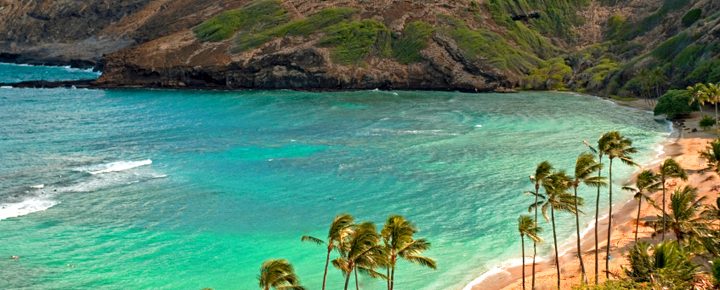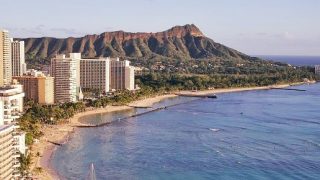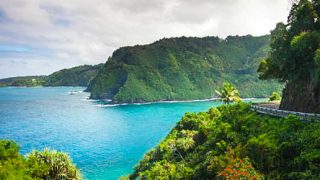A bill now in the Hawaii State Senate seeks to establish a statewide visitor fee program in order to access up to 50 of Hawaii’s beaches, parks, trails, coastline, etc. SB 3192, as current worded, would require park passes for out-of-state visitors only.
There are 50 Hawaii parks on five of the major Hawaiian islands. Ten of these already have non-residents admission and parking fees (typically $5/person and $10/vehicle), including Hanauma State Park pictured here where the entrance fee is now $25/person. Hawaii residents are exempt. If this measure becomes law, the current visitor fees will be replaced with the annual pass.
The bill is currently going through the legislature. If approved, here’s what it’ll do:
“Establish a visitor impact fee program, to be administered by the department of land and natural resources, as a license required by visitors for usage of Hawaii’s public beaches, parks, trails, coastlines, and environment. The purpose of the visitor impact fee program shall be to provide sustained funding for the protection, restoration, and care of Hawaii’s state-owned natural and outdoor recreational resources and build the resilience of these resources to the impacts of increased visitor use.”
Key aspects of the bill provide for the following:
- Any visitor age 15+ who visits a state park, beach, state-owned forest, hiking trail, or other state-owned natural area on state-owned land must pay an impact fee to obtain a license good for one year from the day of the license purchase (violators will be fined).
- Residents would be exempt from paying such fees.
- Once implemented, existing state park entrance fees will be rescinded.
- Money collected will go into a special fund rather than the state’s general fund.
BOH: We don’t know what the state legislature will ultimately approve, but it’s clear that this is the direction in which Hawaii and other similar destinations in the U.S. and worldwide are moving. Furthermore, not specified were 1) what the fees would be; 2) whether there would be any exemptions such as seniors, with disabilities or military; 3) how such a system would be managed; 4) whether admission will be statewide, by island, or per park); and 5) whether reservation transferrable and, perhaps most importantly, what the enforcement and penalty mechanisms would be.
Uhero said, “Importantly, possession of a license may not guarantee entry to a specific state park or natural area if current rules and visitor caps at existing state parks—such as those at Haena State Park—still apply. If a visitor paid for a pass but can’t get reservations (for car and person) to visit Haena State Park, should they be eligible for a refund? As a well-known idiom states, ‘The devil is in the details.’ The Legislature should request DLNR to develop a plan with the requisite details.”
How similar programs work in other U.S. states.
UHero noted that “Hawaii is actually a late-comer among states in the establishment of an annual state parks pass/license.
The way park passes work varies by state. Some offer annual passes that provide either statewide or park-by park access. Programs are either for individuals or are vehicle-associated. Annual passes avoid daily fees. Most states that have annual passes also offer day passes.
Nebraska. Annual vehicle pass $31 for Nebraska vehicles (or $6 per day) and $61 for non-Nebraska vehicles ($12 per day).
Idaho. Annual resident vehicle passport of $10 and non-resident passport of $80.
Iowa. Annual visitor-only pass for $40 at most-visited state parks; also $5 per day option.
Montana. Annual state park fee of $9 paid with vehicle registration. All others pay daily park fees. Nonresidents can either purchase an annual entrance pass for $50 or a 7-day pass for $35.
Washington. Washington State is an example of states that offer free admission days during the year.
Current Entrance Fees at Hawaii State Parks
Hawaii already has a park entry fee system. Hawaii’s State Park System, administered by Department of Land and Natural Resources, Division of State Parks, is composed of 50 parks on five major islands. Ten of them require non-residents to pay both an entrance fee ($5 per person) and a parking fee ($10 per non-commercial vehicle; commercial vehicles pay more); residents with proper IDs are admitted free.
Annual passes have advantages and disadvantages, with one of the major issues being that passes don’t reflect the actual usage impact on individual parks. Entrance fees per park tend to better ration natural resources.
Should residents pay to visit Hawaii state parks?
UHero said “‘Yes.’ Those who oppose charging residents to enter State parks and natural areas argue that residents already ‘contribute significantly’ toward their upkeep through the taxes they pay to the State government. It is the same argument that survived a legal challenge to enable Honolulu County to impose a visitors-only admission fee at the City’s Hanauma Bay Nature Preserve in the 1990s. But the argument is weak. Visitors to Hawaii pay more tax revenues to the State government than what it costs the State to provide services to them. Consider that in 2019, tourism generated an estimated $2.07 billion in tax revenues to the State (including multiplier effects), or about 25% of total State tax collections; but visitors represented only 15.4% of Hawaii’s de facto (tourist + resident) population.”
UHero summed up the argument by saying that “both residents and tourists contribute to park congestion and natural area degradation, and, hence, both should pay.”
We want to hear your input.
Get Breaking Hawaii Travel News







What a terrible idea. What kind of message does this send to Visitors to our State? Red tape just to go to the beach? The loss of Tourist dollars will be more than any park fees brought in. Penny wise, pound foolish.
Really getting tired of all these fees. We pay a large amount of taxes yearly. Is there nothing that benefits the medium income person.
If you are looking to decrease the amount of people who frequent Hawaii. Just keep up what you are doing. Hawaii will end up being the islands for the rich and the rest of us will find somewhere else to go.